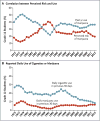Adverse health effects of marijuana use
- PMID: 24897085
- PMCID: PMC4827335
- DOI: 10.1056/NEJMra1402309
Adverse health effects of marijuana use
Conflict of interest statement
No potential conflict of interest relevant to this article was reported.
Figures


Comment in
-
Adverse health effects of marijuana use.N Engl J Med. 2014 Aug 28;371(9):879. doi: 10.1056/NEJMc1407928. N Engl J Med. 2014. PMID: 25162899 No abstract available.
-
Adverse health effects of marijuana use.N Engl J Med. 2014 Aug 28;371(9):878. doi: 10.1056/NEJMc1407928. N Engl J Med. 2014. PMID: 25162900 No abstract available.
-
Adverse health effects of marijuana use.N Engl J Med. 2014 Aug 28;371(9):878-9. doi: 10.1056/NEJMc1407928. N Engl J Med. 2014. PMID: 25162901 No abstract available.
-
Adverse health effects of marijuana use.N Engl J Med. 2014 Aug 28;371(9):879. doi: 10.1056/NEJMc1407928. N Engl J Med. 2014. PMID: 25162902 No abstract available.
References
-
- Center for Behavioral Health Statistics and Quality. National survey on drug use and health. Rockville, MD: Substance Abuse & Mental Health Services Administration; 2013.
-
- Fergusson DM, Boden JM. Cannabis use and later life outcomes. Addiction. 2008;103:969–76. - PubMed
-
- Lopez-Quintero C, Pérez de los Cobos J, Hasin DS, et al. Probability and predictors of transition from first use to dependence on nicotine, alcohol, cannabis, and cocaine: results of the National Epidemiologic Survey on Alcohol and Related Conditions (NESARC) Drug Alcohol Depend. 2011;115:120–30. - PMC - PubMed
-
- Hall W, Degenhardt L. Adverse health effects of non-medical cannabis use. Lancet. 2009;374:1383–91. - PubMed
Publication types
MeSH terms
Substances
Grants and funding
LinkOut - more resources
Full Text Sources
Other Literature Sources
